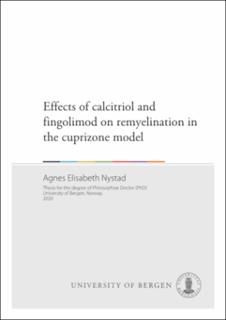| dc.contributor.author | Nystad, Agnes Elisabeth | en_US |
| dc.date.accessioned | 2020-05-22T06:50:41Z | |
| dc.date.available | 2020-05-22T06:50:41Z | |
| dc.date.issued | 2020-06-12 | |
| dc.date.submitted | 2020-05-05T09:00:26.615Z | |
| dc.identifier | container/44/71/d5/7b/4471d57b-0998-483c-a23a-70d49e61d451 | |
| dc.identifier.isbn | 9788230840993 | en_US |
| dc.identifier.isbn | 9788230868966 | en_US |
| dc.identifier.uri | https://hdl.handle.net/1956/22329 | |
| dc.description.abstract | Multiple sclerosis (MS) is a chronic disease characterized by inflammation, demyelination, and neurodegeneration of the central nervous system (CNS). There is no cure. Current treatments target the autoimmune aspects of MS but do not directly improve CNS remyelination. Pro-remyelinating treatment might optimize the treatment of MS patients. In this project, we aimed to investigate different strategies to improve remyelination and mitigate axonal damage in the cuprizone model, an animal model for de- and remyelination. Our goal was to determine the effect of biologically active vitamin D (calcitriol) on remyelination (Paper I), and axonal damage (Paper II). Moreover, we investigated the effect of the MS-medication fingolimod on remyelination and axonal damage in the cerebellum (Paper III). Finally, we assessed the impact of fingolimod in the cerebrum (Paper IV). C57Bl/6 mice were exposed to the neurotoxicant cuprizone. In the vitamin D experiment, high-dose calcitriol or placebo was given by intraperitoneal injections twice a week. In the fingolimod experiment, fingolimod or placebo was given by oral gavage daily. In both experiments, mice were investigated at several time points during remyelination. Histochemistry and immunohistochemistry were used to investigate remyelination, axonal damage, and loss. We analyzed the brain proteome by proteomic analysis to further determine the CNS effects of fingolimod exposure. Treatment with high-dose calcitriol improved the remyelination process (paper I). Vitamin D given before, but not after cuprizone-induced demyelination prevented acute axonal damage and axonal loss (paper II). Given after cuprizone-induced demyelination, fingolimod did not affect cerebellar remyelination, the number of oligodendrocytes, microglia or astrocyte activation, or acute axonal damage at any time point (paper III). Fingolimod was functionally active during remyelination, resulting in a downregulation of sphingosine-1-phosphate receptor 1 protein levels in the brain. We found, however, no difference in the degree of remyelination, oligodendrocyte numbers, nor the degree of axonal damage or loss in the corpus callosum (paper IV). In the cuprizone model, high-dose calcitriol given during remyelination improved remyelination. However, axonal damage was only prevented if vitamin D was given before demyelination occurred. Fingolimod modulated the sphingosine-1-phosphate receptor 1 levels in the cerebrum but did not increase remyelination, nor protect against axonal injury or loss in the cerebellum or cerebrum when given after cuprizone-induced demyelination. | en_US |
| dc.language.iso | eng | eng |
| dc.publisher | The University of Bergen | eng |
| dc.relation.haspart | Paper I: Nystad AE, Wergeland S, Aksnes L, Myhr KM, Bø L, Torkildsen Ø. Effect of high‐dose 1.25 dihydroxyvitamin D3 on remyelination in the cuprizone model. APMIS. 2014 Dec;122(12):1178-86. The article is available in the main thesis. The article is also available at: <a href="https://doi.org/10.1111/apm.12281" target="blank">https://doi.org/10.1111/apm.12281</a> | en_US |
| dc.relation.haspart | Paper II: Nystad AE, Torkildsen Ø, Wergeland S. Effects of vitamin D on axonal damage during de- and remyelination in the cuprizone model. J Neuroimmunol. 2018 Aug 15;321:61-65. The article is available in the main thesis. The article is also available at: <a href="https://doi.org/10.1016/j.jneuroim.2018.05.016" target="blank">https://doi.org/10.1016/j.jneuroim.2018.05.016</a> | en_US |
| dc.relation.haspart | Paper III: Alme MN, Nystad AE, Bø L, Myhr KM, Vedeler CA, Wergeland S, Torkildsen Ø. Fingolimod does not enhance cerebellar remyelination in the cuprizone model. J Neuroimmunol. 2015 Aug 15;285:180-6. The article is available at: <a href="http://hdl.handle.net/1956/10915" target="blank">http://hdl.handle.net/1956/10915</a> | en_US |
| dc.relation.haspart | Paper IV: Nystad AE, Lereim RR, Wergeland S, Oveland E, Myhr KM, Bø L, Torkildsen Ø. Fingolimod downregulates brain sphingosine-1-phosphate receptor 1 levels but does not promote remyelination or neuroprotection in the cuprizone model. J Neuroimmunol. 2020 Feb 15;339:577091. The article is available in the main thesis. The article is also available at: <a href="https://doi.org/10.1016/j.jneuroim.2019.577091" target="blank">https://doi.org/10.1016/j.jneuroim.2019.577091</a> | en_US |
| dc.rights | In copyright | eng |
| dc.rights.uri | http://rightsstatements.org/page/InC/1.0/ | eng |
| dc.title | Effects of calcitriol and fingolimod on remyelination in the cuprizone model | en_US |
| dc.type | Doctoral thesis | |
| dc.date.updated | 2020-05-05T09:00:26.615Z | |
| dc.rights.holder | Copyright the Author. All rights reserved | |
| dc.contributor.orcid | https://orcid.org/0000-0001-6055-9912 | |
| fs.unitcode | 13-24-0 | |
